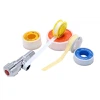PTFE tape can withstand temperatures ranging from -400°F to 500°F (-240° to 260°C). PTFE has a high melting point of about 327°C, but it begins to deteriorate when temperatures rise above 200°C to 260°C. The minimum safe operating temperature of PTFE tape is about -200°C, while the upper limit of heat resistance is often around +260°C. High-density PTFE tapes can withstand temperatures ranging from -200°C to +260°C, while lower-density tapes cannot withstand such high temperatures.




How to apply PTFE tape
When working with PTFE tape, the first and most critical job is always to make sure you are using the correct type of tape for the application. Once confirmed, you should take care to follow these relatively simple steps in order:
1. First, clean the threads of the pipe joint where the PTFE tape will be applied. Existing pipes may have traces of dirt, rust, grease, or other pipe sealants from previous use. With brand new lengths of conduit, the threads may not have been thoroughly cleaned after machining, which means there may be metal shavings or factory oil present that will negatively affect the integrity of the seal formed. You may need specialized products, such as industrial-strength pipe cleaners, to completely remove some stubborn or harsh solvents and grease
2. Allow the cleaned fitting threads to dry thoroughly before attempting any further handling of them. This can usually be achieved with careful use of paper towels, but if possible it's wise to leave them outside to air dry completely. Either way, you have to make sure there are no beads of water trapped in even the tightest channels between or around the threads that will fit together
3. Once the fitting is completely dry, you can begin wrapping the threads with PTFE sealing tape. Start a line from the open end, this will prevent any scraps of cut material from entering the pipe. Wrap in the same direction of descent as the threads, back toward the pipe. This is key to preventing unwanted twisting, such as tape bunching or unraveling when opposite ends of a joint come together.
4. As you work your way down the line, you should overlap the layers of tape by about half the width to ensure full coverage all around. Although some deformation of the material between the threads helps create a tighter seal, be careful to avoid using too much, as excessive deformation can cause problems. When wrapping, pull tight enough to maintain enough tension so that the thread maintains clearly visible ridges even through thicker or more opaque tape varieties
5. Continue in this manner until the end of the last thread reaches approximately one full turn. Finish the final wrap by cutting and gluing the final length of loose tape, making sure nothing is improperly adhered and the cut end presses smoothly and seamlessly against the rest of the wrap
PTFE tape forms a tight-fitting skin or seal around the threads of various joint types in ductwork and pipes.
In addition to acting as a deformable filler and helping to prevent leaks (provided the tape is dense and thick enough), it also lubricates the joint threads. The extremely low surface friction of PTFE is responsible for this lubricating effect. In fact, PTFE has one of the lowest coefficients of friction of any known solid!
Proper application of PTFE tape will provide a tighter fit on the pipe fitting threads and will also prevent them from seizing if they need to be unscrewed in the future.










